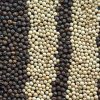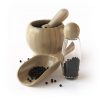
Black pepper is a tropical vine native to India and Southeast Asia and is admired for having many health benefits. It produces small, dark brown berries used in cooking, especially for seasoning meat dishes. The berries can be dried to make black pepper powder (also called ground or coarsely ground pepper). Growing black pepper plants is not easy because these tropical plants require warm temperatures year-round. But if you live in an area where it does not get below 55 degrees F at night (which includes many parts of the United States), then you may be able to grow black pepper plants indoors or outdoors as long as temperatures do not drop 40 degrees F below during the day—for instance, from May through September in California.
A Complete Guide to Growing Black Pepper Plants:
The black pepper, Piper nigrum, is a tropical plant grown for black, white, and red peppercorns. The three colors of peppercorns are different stages of the same peppercorn. Follow these steps for growing a black pepper plant:
How to Grow a Black Pepper Plant
The most common way to grow your black pepper plant is via seeds.
STEP 1. Choosing Fresh Seeds for this.
Black pepper seeds are only feasible for a shorter time and don’t store well over months. Choose new seeds from a healthy plant or a local garden center.
STEP 2. Soak the seeds.
Let the seeds soak overnight to soften their thick seed coats, making it easier for seedlings to sprout.
STEP 3. Plant the seeds.
Use loamy soil high in organic matter and plant the seeds one-quarter-inch deep and three inches apart.
STEP 4. Keep the soil warm and evenly moist
Water the soil regularly, keeping the soil moist as the seeds sprout and grow leaves. Maintain temperatures around eighty degrees Fahrenheit. Germination can take up to a month.
STEP 5. Transplant
Once young plants are at least six inches tall, you can transplant them into your garden or any container.
A few Tips you must consider while growing Black Pepper Plants
Black pepper plants need a lot of care to thrive.
1. Providing the Right Light. Black pepper plants do best in a spot with partial shade that receives around six hours of direct sunlight per day or in full sun if your climate has mild summers. If you’re growing your pepper plant indoors, choose a windowsill with plenty of morning sunlight.
2. Preparation of the Soil. Unlike many other plants, black pepper plants prefer to stay moist all the time, and they thrive in dense soil that retains a bit of moisture rather than in well-draining soil.
3. Maintaining the soil Humidity. Black pepper plants aren’t drought-tolerant and need their soil to stay consistently moist. Water your black pepper plant regularly to keep the soil wet around its roots.
4. Keep Humidity High. Black pepper plants prosper in high humidity. If the area isn’t naturally moist (humid), then grow a pepper plant in a greenhouse or indoors as a houseplant near a humidifier to maintain humid conditions.
5. Provide Warm Temperatures. Black pepper plants aren’t cold-hardy and require temperatures above sixty degrees Fahrenheit to survive. If your area’s temperatures threaten to dip below sixty degrees Fahrenheit, consider moving your black pepper plant inside for the winter.
6. Growing it Near a Trellis (framework). As climbing vines, black pepper plants need a robust support system—plant it near a trellis, cage, fence, or mature tree so its vines can grow upward.
Harvesting a Black Pepper Plant
Follow these steps to harvest the mature fruits of the black pepper plant.
1. Waiting until the fruit reddens.
Immature peppercorn fruits grow in green clusters on the vine, gradually turning red as they ripen. Once the peppercorns have turned red, you can pluck them from the vine. (If you harvest the green peppercorns before they’re ripe, you’ll produce green pepper.)
2. Drying Stage
Separate the red peppercorns on a tray and let them dry in the sun (or in a food dehydrator) for at least three days. You’ll know they’re ready when they turn black and hard. (To produce white pepper, remove the red hulls from the peppercorns before drying them.) You can store whole peppercorns in an airtight container.
3. Grinding Stage
When you’re ready to add black pepper to a dish, grind the dried peppercorns in a pepper grinder or use a mortar and pestle. You can also grind the black peppercorns early and store the ground black pepper for later use.
OTHER THINGS TO CONSIDER
It’s a tropical vine that grows up to 15 feet tall. You will need plenty of space in your garden for this plant, as it is a large vine capable of covering large areas with its extensive root system. It also requires a lot of water and sun, so ensure you can provide both!
KEEP SOIL MOIST AT 70 DEGREES FAHRENHEIT
You’ll have to keep the soil moist but not wet. It’s important not to let the plant dry out, or it could die. Make sure to water regularly and keep your black pepper plants in a sunny location with temperatures between 70-80 degrees F. Watering in the morning will prevent sunburn on your plants, which happens if they get too much sunlight while they are still wet from watering them.
REQUIRES SUPPORT
Pepper plants are heavy and can grow up to 20 feet long. They will need to be tied to a support structure or trellis at least every 2 weeks. Support poles should be at least 1 inch in diameter and have an inside diameter of 4 inches. Use a nylon cord, twine, or wire for tying the pepper vines onto the support system. Please do not use any material that will rot or decay because it may cause damage to your plant’s roots by holding moisture against them for too long (such as rope).
REQUIRES ANNUAL TRIMMING
Growing black pepper, like other plants and trees, requires annual pruning. This will help your plant grow healthier and stronger each year.
Black pepper can get quite tall; therefore, it is essential to keep trimming back old stems that no longer produce new growth or flowers. When you trim back old stems, you encourage the plant to grow new branches that will flower in future years, as well as provide fresh fruit for cooking. You also want to be careful when removing flowers because they are crucial for developing new fruit later. It’s imperative not to draw too many flowers when growing black peppercorns because they don’t self-pollinate—unless pollen from another plant lands on them. At the same time, they’re open (for seeds/fruit to develop), so there won’t be any more offspring produced!
IT CAN BE GROWN IN POTS
Black pepper is a tropical plant that requires rich soil, lots of light, and careful watering. It often needs trimming to keep it looking nice. Black pepper can be grown indoors or outdoors in pots, although the seeds must first be started indoors. The plants will grow best in a greenhouse.
It’s hard to grow, but possible.
If you’re interested in growing black pepper, you’ll need to know that it’s a tropical vine. You’ll also need to keep it moist and warm. In fact, the ideal temperature range for black pepper plants is between 70 degrees Fahrenheit (21 degrees Celsius) and 80 degrees Fahrenheit (27 degrees Celsius). They also need plenty of sunlight—about 4 hours per day or so—but not too much heat or direct sunlight.
Black pepper vines need support if they’re going to grow properly. They can be trained up trellises or poles like other climbing vines, but this isn’t always possible when growing indoors: frameworks take up too much space on an indoor porch or deck; simply tying them up with twine can leave them exposed to too much wind if there is no protective structure nearby.
INSTRUCTIONS
- Pepper is a warm-growing plant that will stop growing when below 65F and will not tolerate any amount of frost. Fortunately, they make excellent container plants.
- Pipers like to be in partial to full sun with 50 percent or better humidity (although they do fine below 50 percent. Plants should be watered thoroughly when the soil appears dry.
- Black peppercorns are moderate to light feeders and should be fed with a 10-10-10 fertilizer 1/4 tsp per gallon every 1-2 weeks (discontinuing in the winter)
- Pipers should be grown under bright light for peppercorn production and kept warm. They are vining in nature and slow growing. It will take a couple of years before they start producing flowers, then peppercorns.
CONCLUDING REMARKS
If you have access to an outside area where you can train your black pepper vine up a pole or trellis, then by all means, do so! It’s easy enough for most people who enjoy gardening at all (or even just like being outdoors). One thing that makes growing black pepper difficult indoors is its requirement of frequent trimming: every few weeks throughout the year, especially during its first year of growth, and again after fruiting begins in late summer/early fall each subsequent year until maturity (about ten years total).
Taiba Tariq
Taiba Tariq is a healthcare nutrition hobbyist, enthusiastic about researching healthcare & skincare news while analyzing the latest and science-backed evidence about nutrition, skin care, and supplements. She wants to help people regain their beauty, health, and well-being through natural means.
all author posts






